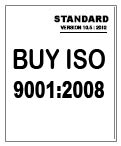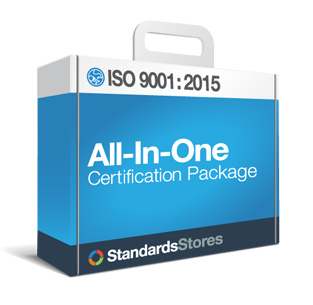How Much Will ISO 9001:2015 Change The Way You Do Business?
The Next Steps in Rolling Out the Updated ISO 9001 2015 Standard
This is the second part of a two part series on the revised ISO 9001 2015 standard fro a view of someone who is on the actual drafting committee. The 9000 Store has been interviewing J.P. Russell (Credentials below) on key issues such as documentation, auditing, risk and restructuring of the standard.
ISO 9001:2015 is set to replace the existing ISO 9001:2008 standard, which is still required for current ISO certification
While Mr. Russell has been intimately involved in both this revision (and the last one ISO 9001:2008) he notes that “The following comments represent my personal observations and conclusions and not that of any organization I am a member or active participant. Nor is this an analysis of proposed requirement changes you may expect in the future.”
“[in the new standard] There is more social responsibility . We can’t be hermits. For example, the food safety standard, ISO 22000, is very big on involving everyone along the food chain, even though it is very much oriented to food processing plants. So, if there is some kind of issue with food contamination… you need to involve all elements. “
J.P. Russell, member of the U.S. technical advisory group for International Organization for Standardization technical committee 176, responsible for the f ISO CD 9001:2015 revision.
Segment 1: The Changing Role of Auditors Under ISO 9001 2015
The 9000 Store: So as a “full time” external auditor, how do you see the guidelines that are now being discussed affecting those who have periodic “internal auditing” duties? What type of additional training will they need?
JP Russell: As now, all auditors are required to be competent, so there will be a requirement even for internal auditors to audit to the standard’s requirements.
The 9000 Store: In the preliminary draft that was issued last year of the new 2015 standard, it made no mention of a management representative. With a potential for the standards to be less prescriptive, how will this affect the assurance that the quality management system is working effectively, for example, that internal auditors are competent?
JP Russell: There will still be a top management function to appoint people who are responsible for the quality management system. As forces try to build more flexibility into these standards, there’s more pressure on the people implementing the QMS and the people auditing system to understand the concept of control. So, it won’t be, “I comply because I have a documented procedure.” The issue will be, “Is this system under management’s control and is it effective?” If it is, you should pass [certification]. It might require a higher understanding level of the intent of the control and how it is supposed to work.
Segment 2: The Reason ISO Must Move to a Common Structure for All Standards
The 9000 Store: When a company adopts two standards, such as ISO 14001 and ISO 9001, there is work to be done to “harmonize” them, so a common structure makes sense. But the majority of companies still comply with a single standard. Will restructuring the standard to use the same core with Annex L be any advantage to those creating so-called “integrated management systems”?
JP Russell: There are people who are not happy with the idea of using [Annex L] to restructure all ISO management standards [such as ISO/IEC 27001 has been]. So we may have some sectors not adopting the new structure such as those standards based on ISO 9001 such as ISO/TS 16949. We’ll have to see. The concept behind a universal management system for quality on a world-wide basis is very powerful. So at the end of the day, if you’re dealing with someone in South Africa or France, and you say ISO 9001, everyone is immediately on the same page. So we may see some of these sectors change their mind, even though groups like automotive and medical instruments have expressed their concern.
You talked about integrated management systems. That’s the main advantage of everyone having the same structure. For example, if all standards have a section on improvement, whether it’s environmental, safety or general quality, security, it’s all going to make implementation easier. I was working with a Fortune 100 company to pull together seven different quality standards under one umbrella, and it’s certainly easier to do this with a common structure.
Will The New “Common Core” for All ISO Standards Really Work?
While ISO 9001 2015 draft committee member JP Russell admits that “there are people who are not happy with the idea of using [Annex L] to restructure all ISO management standards,” he says the idea of having a truly identical quality standard operating internationally is very powerful. He says even at the risk of having the over 1 million companies that use ISO9001 need to restructure their quality management systems a bit, the long-term value of a new, rationalized structure will bear many benefits.
Segment 3: But Is Taking Risk and the Entire Business Environment Into Quality Planning Realistic?
The 9000 Store: One of the criticisms we have heard is that this ISO 9001 2015 revision is leaving the realm of quality and getting into broader business management disciplines, and because of this may be difficult to audit.
JP Russell: Well when we talk about risk it will have to be how it impacts quality, and not some other aspect of the business. Everyone is staying in their specific area. And we want people to use their tools to manage risk. An example would be the use of FMEA to identify risks to quality.
The 9000 Store: So in a sense we’re staying true to how ISO 9001 was originally codified which was as a quality management system. The ISO 9001 2015 draft committee just wants a broader range of possible impacts to be considered?
JP Russell: I would agree.
The 9000 Store: Would you also agree that this falls into elements of the original ISO 9001 process that wasn’t particularly well articulated? In this case, the standard already considers risks to business operations like quality. Does it make sense to just make them more prescriptive?
JP Russell: I would agree. If you are looking at a risk to your QMS, isn’t that just another preventative action?
The 9000 Store: Wouldn’t this force the quality personnel to be more familiar with broader business objectives and operations?
JP Russell: Yes, and I don’t know where that’s going to go, but obviously understanding risk is a little higher level. If we go down this road, whoever is over quality, the skill requirements are going to change. That said, we’re still operating in a pretty basic realm. For instance, we’re not requiring things like Six Sigma. But we are adding what we think are appropriate business controls as we move forward.
The 9000 Store: What about the idea of involving more “constituencies” such as vendors or even localities where major operations take place in the quality process.
JP Russell: [During the drafting process] We’ve used the term “interested parties.” There is social responsibility. We can’t be hermits. I’d say you’re going to see more of that and the need for it. I can’t say what the exact wording will be, but I will say the new standard will be more open to bringing in interested parties. You know the food safety standard, ISO 22000, is very big on involving everyone along the food chain, even though it is very much oriented to food processing plants. So, if there is some kind of issue with food contamination [which can happen anywhere from growing, harvesting, processing, preservation or delivery], you need to involve all elements. So I think that’s the direction we’re headed with this and I also think it’s the right thing to do.
Segment 4: Will the ISO 9001 2015 Revision Really Get Published in 2015?
The 9000 Store: You’ve been through two ISO 9001 standard re-writes. How are things going this time compared to the past? Are you going to make your deadlines?
JP Russell: I think it’s going fairly well. I’m part of the United States’ contingent, one of 60 countries. And we’ve done our part to make sure the revisions are clear, and not ambiguous. I think we’ll make our 2015 release, even if it may be late in the year.
The 9000 Store: Are there any areas of disagreement?
JP Russell: Well, the US argued against any type of reorganization since there are so many more ISO 9001 certifications, but we didn’t get our way. But we’re just one vote on that. There are things people don’t like about the new standard, but it’s very powerful that all companies worldwide will be on the same page.
The 9000 Store: What’s your formal role on the committee.
JP Russell: I represent that audit section of ASQ on the committee. I’ve been secretary of various ISO committees. I’m on the ISO committee that monitors auditing standards. I went to my first TAG meeting in 1988.
The 9000 Store: Where is the official and unofficial goalpost for the revision?
JP Russell: We’re still reviewing the draft and there are still quite a few changes and things to settle. We’re dealing with people from all around the world whose first language is not English. So it’s slow and hopefully we’ll come up with something everyone will be proud of. We’re at a working draft stage, which is not available to the public. The committee draft will go to a “Draft International Standard” when it’s ready.
JP Russell Profile
J.P. Russell is the founder and managing director of Quality WBT Center for Education. He also is an ASQ fellow, ASQ-certified quality auditor, and a voting member of the American National Standards Institute/ASQ Z1 committee. He has authored numerous guides on the auditing process including “The Process Auditing and Techniques Guide,” “The Internal Auditing Pocket Guide” and “After the Quality Audit: Closing the Loop on the Audit Process.” Russell is a recipient of the Paul Gauthier Award from the ASQ Audit Division. Most relevant for the upcoming ISO 9001 revision, he is a member of the U.S. technical advisory group for International Organization for Standardization technical committee 176, which is charged with drafting ISO 9001:2015.
Previous: An Insider’s View On The ISO 9001 2015 Revision
Past (Obsolete) versions of ISO 9001 Standard include:
- ISO 9001:2000 was replaced ISO 9001:2008 in the year 2008
- ISO9001:1994 had three versions:
- ISO 9001:1994 – Manufacturing with Design & Development
- ISO 9002:1994 – Production and Installation (No Design)
- ISO 9003:1994 – Final inspection and test
- What Changed from 1994 to 2000?



